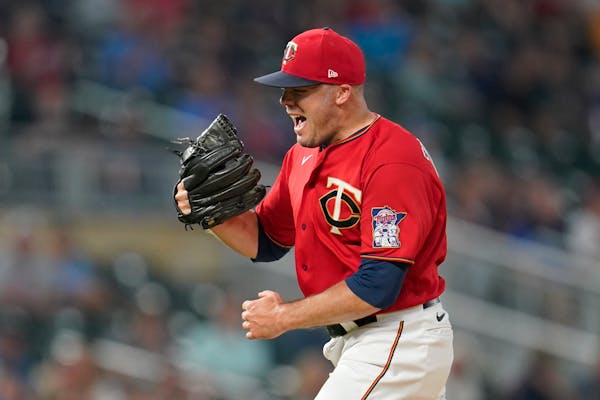 See
more of the story
See
more of the story
Monday night he was Max, not minimum, Kepler.
The Twins right fielder broke the longest hitless streak in the majors, 29 at-bats, with a second-inning single. He singled in the fourth and doubled in the sixth, contributing to a 4-2 victory over Kansas City at Target Field.
If this was an omen, there might be hope for a team that has been bumbling for months.
Following two unsightly losses to the not-even-trying Angels over the weekend, the Twins returned home Monday having gone 31-39 in their previous 70 games, roughly coinciding with pitcher Joe Ryan going on the COVID-19 list.
Even trades for three pitchers and a catcher haven't dramatically changed their fortunes. They were 54-48 before the deadline; they are 5-7 since.
Their slump is a reminder that while the bullpen receives the bulk of the criticism, and injuries are a legitimate excuse, there is one everyday player whose performance has killed the lineup: Kepler.
The Twins entered the season with plenty of quality righthanded hitters, led by Byron Buxton and Carlos Correa. They needed at least one of three lefthanded hitters to produce to lengthen and balance their lineup.
Alex Kirilloff produced three home runs before a chronic wrist injury led to surgery. Trevor Larnach demonstrated his promise from April 27 to June 10, hitting five home runs and producing an all-star caliber OPS of .878. He, too, got hurt.
That left two lefthanded hitters who could bat in the middle of the lineup and produce runs — Jorge Polanco, a switch hitter who is having an underwhelming season by his standards, and Kepler, who is having a poor season by the standards of corner outfielders.
Polanco's OPS is .748, giving him an OPS plus (his on-base-and-slugging percentage compared to league average) of 116, with 100 being the league average.
Entering Monday, Kepler's OPS was .677. His OPS plus was 97. That means his offensive production is below average among all players, and severely below average compared to modern corner outfielders.
Before the injury — Kepler broke his right little toe when hit by a Rony Garcia pitch on July 24 against Detroit — his OPS was .734, a little lower than Nick Gordon's.
This is Kepler's seventh full major league season. He has been markedly above average in one — when he hit 36 homers and had an OPS of .855 in 2019, that magical year when every Twin became Hank Aaron.
Kepler has posted a full-season OPS of better than .760 only once. He has one more year remaining on his contract, at $8.5 million for the 2023 season. The Twins have a $10 million option on him for 2024, with a $1 million buyout.
He has time to make himself indispensable, but the 2022 Twins need him to produce right about now.
"He's been as important of a cog in the machine here since I've been here," Twins manager Rocco Baldelli said. "He always plays a good right field. … We're going to be looking for really meaningful contributions from him."
What's remarkable about the Twins' 2019 home run record is that just about everyone in the lineup overperformed. Four starters posted a career high in home runs, dating to today — Mitch Garver (31), Miguel Sano (34), Eddie Rosario (32) and Kepler (36).
Garver was traded. Rosario was released. Sano is injured and headed to free agency.
Kepler outlasted Rosario because of Rosario's poor fielding and baserunning and undisciplined at-bats. He outlasted Sano because of Sano's strikeouts and injuries. He outlasted Garver because the Twins had decreased their expectations for Garver enough to include him in a trade.
Kepler is a better fielder and more reliable baserunner than Rosario, and he doesn't strike out at Sano's maddening rate. He also looks like the kind of athlete who is about to figure out the game and hit .300 with 40 home runs.
Instead, Kepler is producing his most disappointing season at the age of 29, the prime of his prime.
Kepler should be batting fourth or fifth. He should be one of the Twins' five best players. Monday night, he looked like he was.




![Minnesota Twins pitcher Jhoan Duran (59) in the ninth inning Tuesday, August 15, 2023, Target Field in Minneapolis, Minn. ] CARLOS GONZALEZ • carlos](https://arc.stimg.co/startribunemedia/NWLT5CNXGTRZA6KVTMIPSOG3KI.jpg?w=75&h=75&fit=crop&crop=faces)

